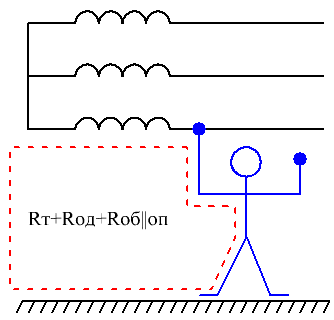Categories: Interesting Facts, Safety precautions
Number of views: 107321
Comments on the article: 1
Resistance of the human body - what it depends on and how it can change
When a person gets under electric voltage, an electric current begins to flow through his body, and the magnitude of this current depends not only on the magnitude of the applied voltage, but also on the resistance of the human body. Meanwhile, the resistance of the human body is by no means constant; its value depends on many factors: on the state of the person at the moment of contact (mental and physical), on the parameters of the closed circuit, on the external environmental conditions in which the person is at the time of the impact.
The human body consists of various tissues, and each type of tissue has its own resistance. So, for example, tendons, skin, adipose tissue, cartilage and bones have a resistivity of the order of 3 - 20 kOhm / m. Blood, muscles, lymph, brain and spinal cord - only from 0.5 to 1 Ohm / m. Of all these tissues, skin is the most resistant; therefore, it is the skin that largely determines the resistance of the human body to electric current.

Human skin has a complex structure. Its outer layer - the epidermis - includes several structural parts: the outer stratum corneum, which contains neither nerves nor blood vessels, therefore has the highest resistance, and other layers whose resistance is much less than the stratum corneum. Next is the dermis - the inner layer, the resistance of which is also much less, which means that the resistance of the stratum corneum is crucial in the total resistance of the skin.
Skin resistance is affected by its condition. If the skin is dry and clean, has no damage, then its resistance lies in the range from 10 to 100 kOhm. If there are cuts, scratches, microtraumas on the skin, they can greatly reduce the resistance of the human body to the resistance of only internal tissues. Obviously, the presence of the above mentioned lesions on the skin makes an electric shock more dangerous. Contaminated and moist skin also has lower resistance.
The total resistance of a human body that has come under stress can be represented as consisting of three resistances, connected in series: two layers of the epidermis and one - resistance of the dermis and internal tissues. Thus, the internal tissues serve together with the applied electrodes as if capacitor platesand the epidermis is a dielectric.

As a result, if electrodes are applied externally to the body, a circuit is obtained from the active resistance of the internal tissues and the almost capacitive resistance of the epidermis. That is, we can say that we are talking about the dielectric constant from 100 to 200, and about the resistivity from 10 to 100 kΩ / m in a circuit consisting of a capacitor and resistor.

Internal tissues have an active resistance Rv with a small capacitive component, which is almost independent of either the area of the electrodes or the frequency, and ranges from 500 to 700 Ohms.

But it depends on the length and cross section of body parts, and on the resistivity of internal organs. That is, in equivalent form, the total resistance Zm of the human body can be represented as follows:

With a small resistance of the human body, the capacitive component loses value:

So, the electrical resistance of the human body depends on the following five factors:
-
From the general psychological and physiological state (individual characteristics);
-
From the floor - from the thickness of the skin (in men, resistance is higher than in women);
-
From age - from roughness of the skin (in adults, resistance is higher than in children);
-
From external conditions (temperature, pressure, humidity, density);
-
From the general condition of the skin (wounds, dirt, moisture, etc.);
-
From external stimuli (sudden blow, injection, light or sound) that can reduce resistance by 20 - 50% in a few minutes.

It is easy to see that the electrical resistance of the human body is not constant and not linear, but for calculations it is assumed to be 1 kOhm. Nevertheless, the resistance of the human body also depends on the applied voltage, since at the time of electric shock it may turn out that the circuit also includes the floor surface, soil, shoes, clothes, etc. The current will then determine not only the resistance of the body itself person, but also the scheme of its inclusion in the chain.
Two-phase touch

With a two-phase touch, a person stands on an isolated base, touching at the same time two phases of a three-phase network, or two conductors of a single-phase AC or DC network. In this case, the current will flow through the hands and through vital organs, which is very dangerous, and even more dangerous if the circuit occurs along the arm - head path. With this touch, a person can get either under linear interphase voltage or under the full operating voltage of the electrical installation.

If a person touched open parts of the body, then the resistance is determined by the resistance of the body, the resistance of the skin, if contact has occurred with the poles through the clothes, then the resistance of the clothes is added sequentially to the circuit.
You can compare these two options. The resistance of dry clothes is from 10 to 15 kOhm, and for wet clothes - from 0.5 to 1.5 kOhm. Obviously, the resistance of the clothes in one way or another limits the current through the human body, although it drops 10 to 30 times if the clothes are wet.
With dry clothes, the shock is felt in a strong trembling from fingers to the wrist, this is 20mA at 220 volts. If the clothes are wet, then at 140mA hands can only be torn from contact points with certain efforts. The resistance of the shoes and the floor is not taken into account here, since they are not included in the chain.
Single phase or single pole touch

A person stands on the ground, and only with one part of his body touches the electrical installation under voltage, and the potential of the electrical installation differs from the potential of the earth or other supporting surface. In this case, a person falls under voltage relative to the earth, and the current through the body will be the earth fault current.
The current path through the loop head - legs or arm - legs, while through vital organs. Resistance will be included in the chain: bodies, clothes, shoes, supports. Resistance shoes and supports are connected to each other in parallel.
Depending on the material of the sole, whether it is wet or dry, the resistance of the shoe will be different. An important role is played by the floor material (supporting surface):
-
Wet leather sole has a resistance of 500 Ohms, dry - 100 kOhm;
-
Wet rubber sole - 1.5 kOhm; dry rubber sole - 500 kOhm;
-
Metal floor - from 0 (dry) to 10 Ohms (wet);
-
Dry earth - 20 kOhm, wet - 800 Ohm;
-
Dry concrete - 2 megohms, wet concrete - 900 ohms;
-
Dry linoleum - 1.5 MOhm, wet linoleum - 50 kOhm;
-
Dry stone - 8.5 kOhm, wet stone - 5 kOhm;
-
Snow or ice - from 300 ohms to 2 megohms;
-
Dry sand - 8 kOhm, wet sand - 1.6 kOhm;
-
Dry black soil - 160 Ohms, wet black soil - 50 Ohms.
As you can see, the resistance of the support and shoes play an important role, and often many times exceed the resistance of the human body, especially in the dry state, which can sometimes save lives.
When you touch the installation case, which for some reason turned out to be energized, if there is no grounding, then all the current will go through the body. If grounding is present, then the main part of the current will go through the earth, and through the body - only a small part, this represents a lesser risk to life.
Step voltage

If a person is standing on the ground near the ground electrode system, and current flows through the ground, then this current can partially flow through the legs through the body of the person - through the loop leg - leg, that is a person will fall under step voltage. A sequential chain is formed consisting of the resistances of the support, shoes and body.Resistance of shoes and supports play a decisive role here, and in a dry form they are able to take on more stress than a naked body will accept.
See also at bgv.electricianexp.com
:
